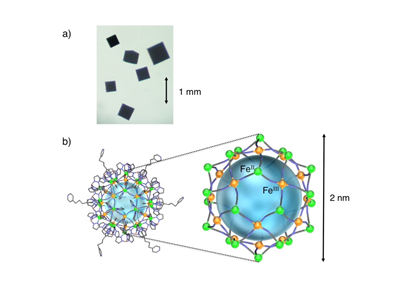a) Photo of cubic crystals consisting of Fe42 nano cluster molecules.
b) Molecular structure of an Fe42 nano cluster molecule clarified at the Beamline BL02B1/SPring-8 for single crystal structure analysis.(Divalent and trivalent iron atoms are shown with green and orange spheres, respectively.) Iron-atom network forms a hollow cage (blue sphere with a diameter of 1.5 nanometers) capable of accommodation of other chemical species. 1 nanometer is a part per billion meter.
Fe42 Magnetic Cage Nano-cluster Molecule Successfully Synthesized
A collaborative research by Kyushu University, Dalian University of Technology, Japan Synchrotron Radiation Research Institute (JASRI), Kumamoto University, Kyushu Institute of Technology, Osaka University, and Tohoku University yielded a magnetic cage nano-cluster molecule, recording the world hugest ground-state spin quantum number (S = 45). This molecule was structurally identified at SPring-8 (JASRI) and magnetically characterized at Pulsed High Magnetic Field Facility (Tohoku University).
These days worldwide competitive researches are conducted on the field of molecular magnetism, aiming creation of artificial magnetic molecules with huge spin as nanoscale permanent magnets. The collaboration group succeeded in winning the world record of molecular magnetization (90 Bohr magnetons) by the precise molecular design of nano-cluster molecule in which ferromagnetic interactions are effective between eighteen paramagnetic iron atoms on the molecule. At the same time, this molecule is interesting in its hollow cage shape capable of accommodation of other molecules as a molecular flask.
These results are to be reported on an online journal, Nature Communications, in the title of “A ferromagnetically coupled Fe42 cyanide-bridged nanocage” at 19:00(JST), January 6, 2015.

(Link) http://resou.osaka-u.ac.jp/en/research/2015/20150106_1









